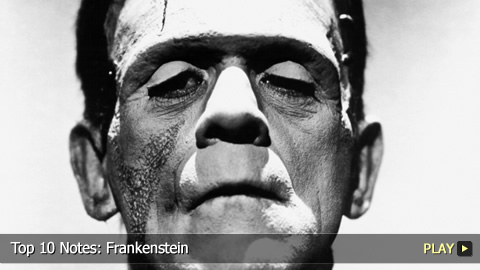Top 10 Notes: Frankenstein

#10 – About the Author
Born in 1797 in London, England to political philosopher William Godwin and feminist pioneer Mary Wollstonecraft, Mary Shelley was raised and tutored by her father after her mother’s death. She fell in love with the poet-philosopher Percy Bysshe Shelley in her late teens and wrote her “Frankenstein” novel in the mid-1810s. Though her later life was plagued by money problems and her children’s deaths, Shelley continued writing her own material and editing her late husband’s work.
#9 – Influences and Inspirations
Shelley conceived the storyline for “Frankenstein” while she and Percy Bysshe Shelley were in Geneva with fellow writers Lord Byron and John Polidori. Their discussions of natural philosopher Erasmus Darwin’s experiments led her to dream about a scientist who brings his creation to life. This eventually became the novel, “Frankenstein: or, The Modern Prometheus,” which she wrote by incorporating Gothic horror, the supernatural, and what are considered early elements of science fiction.
#8 – Settings and Era
Set in the 18th century, “Frankenstein” takes place in various European locations, from Switzerland and Germany, to England and Scotland. Though it’s influenced by that century’s idea that organisms could be brought to life using electricity, Shelley actually wrote the story in the 1800s. Other influences include the poetry of Ovid, John Milton and Samuel Taylor Coleridge.
#7 – Plot
“Frankenstein” opens with Captain Robert Walton’s letters to his sister and continues with a narrative by a scientist named Victor Frankenstein. After giving life to an inanimate creature, Frankenstein is convinced to build a mate for his creation. But when he demolishes this new creation, the angry monster kills the scientist’s friend and wife. Frankenstein swears revenge but ultimately meets his death after meeting Walton, leading to the saddened monster’s decision to sacrifice itself.
#6 – Victor Frankenstein
Born in Geneva, Victor Frankenstein is captivated by science and begins experimenting with reanimation in university. Frankenstein quickly abandons his work after one experiment produces a horrifying monster. His subsequent decisions involving the monster eventually lead to the death of his loved ones as well as his own.
#5 – The Monster
With its yellow eyes and skin, black lips and hair, eight-foot tall frame and straight white teeth, Frankenstein’s creation is revolting upon first impression. But there’s more to this monster than meets the eye: despite its maker’s rejection, it learns to speak and read by observing humans from afar. But his physical appearance still drives people away – Frankenstein himself cannot complete the task of creating its mate. Though the monster responds with anger and hate, it ultimately regrets its actions.
#4 – Values and Themes
Two of “Frankenstein”’s main themes revolve around the potential for destruction in one’s quest for knowledge and how unnatural forces can lead to monstrous results. Meanwhile, the mysteries of science and nature provide a backdrop for the lessons and experiences of the novel’s characters. The book also raises ethical issues with respect to Frankenstein’s act of giving life to a non-living thing and whether or not human beings should be able to do this.
#3 – Modern Popularity
First published anonymously, “Frankenstein” overcame poor early reviews to amass legions of fans. Its popularity quickly increased with multiple language translations and theatrical adaptations. By the next century, critics came to see the work in a much more favorable light, highlighting its gothic elements and the ethical issues it raises. The book is now considered a forerunner in science fiction that has greatly influenced the horror genre.
#2 - Literature Adaptations
Aside from various stage and Broadway productions, “Frankenstein” and the story of his monster has been written about by dozens of authors. These range from sequels to completely original fictional pieces and parodies to children’s books and comic books.
#1 – Screen Adaptations
Following the 1910 silent film adaptation, Frankenstein and his monster have continued to horrify, mesmerize and entertain us on the big and small screens well into the 21st century. However, the story’s most well known adaptation remains Universal Pictures’ “Frankenstein” in 1931. Boris Karloff has been associated with his portrayal of The Monster in that film ever since and even appeared in several Frankenstein-related projects thereafter.
Do you agree with our list? What’s your favorite piece of “Frankenstein” trivia? Be sure to subscribe to WatchMojo.com for more entertaining top 10s.